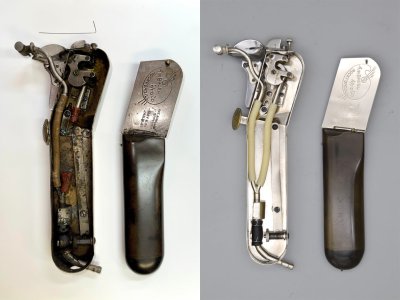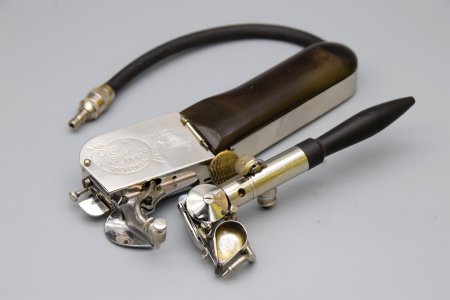DaveG
Airbush Analyst
Several weeks ago I was contacted by a fellow airbrush collector and friend. He asked if I would be interested in taking a stab at restoring a Liberty Walkup airbrush. The significance of the Walkup in airbrush history is tough to overlook. (More about it's history can be found here: https://www.airbrushmuseum.com/airbrush_museum_01.htm )
Having actually seen the brush for sale and making the decision to pass on it myself (due to other financial obligations at the moment) I could not resist the opportunity to get my hands on it- so, agreed to take a look at doing a restoration. I asked the new owner how far he wanted to take it. The brush could be cleaned as well as possible, and left in the working condition it was in when found (it was completely inoperable). It could be cleaned, mildly repaired, and made to function somewhat. Or, it could be completely restored... He made it clear his intention was to use the brush, so the decision was made to make the brush as complete as possible.
This particular brush dates to approximately 1886 or 1887 in manufacture. By far, the oldest piece I have had here. It was also the most damaged piece I have ever seen in my life, that could still be considered "functional". There is just about no part of the brush that was not bent, scratched, or repaired at some point in it's @136 year life span. I have an album on my FB page where I go into some of the restoration work I have done with this piece - https://www.facebook.com/media/set/?set=a.287443396702234&type=3 . As time permits I will try to document some of it here for those interested that don't do FB...
Here is a sample of before and after -

I am still working on adjusting and tuning the brush, but it does at least function.

The brush is a turbine - it is a design Paasche "borrowed" to build the AB Turbo. It has a turbine wheel, split air paths, and a reciprocating needle that passes through a paint "spoon". It gets held in your hand, parallel to the working surface, trigger operated with the thumb. The paint is stripped from the needle tip by an air blast nozzle and deposited straight down. Trigger functions as a double action, with air first when the trigger is squeezed in, and more paint when the trigger is drawn back.
Having actually seen the brush for sale and making the decision to pass on it myself (due to other financial obligations at the moment) I could not resist the opportunity to get my hands on it- so, agreed to take a look at doing a restoration. I asked the new owner how far he wanted to take it. The brush could be cleaned as well as possible, and left in the working condition it was in when found (it was completely inoperable). It could be cleaned, mildly repaired, and made to function somewhat. Or, it could be completely restored... He made it clear his intention was to use the brush, so the decision was made to make the brush as complete as possible.
This particular brush dates to approximately 1886 or 1887 in manufacture. By far, the oldest piece I have had here. It was also the most damaged piece I have ever seen in my life, that could still be considered "functional". There is just about no part of the brush that was not bent, scratched, or repaired at some point in it's @136 year life span. I have an album on my FB page where I go into some of the restoration work I have done with this piece - https://www.facebook.com/media/set/?set=a.287443396702234&type=3 . As time permits I will try to document some of it here for those interested that don't do FB...
Here is a sample of before and after -

I am still working on adjusting and tuning the brush, but it does at least function.

The brush is a turbine - it is a design Paasche "borrowed" to build the AB Turbo. It has a turbine wheel, split air paths, and a reciprocating needle that passes through a paint "spoon". It gets held in your hand, parallel to the working surface, trigger operated with the thumb. The paint is stripped from the needle tip by an air blast nozzle and deposited straight down. Trigger functions as a double action, with air first when the trigger is squeezed in, and more paint when the trigger is drawn back.

